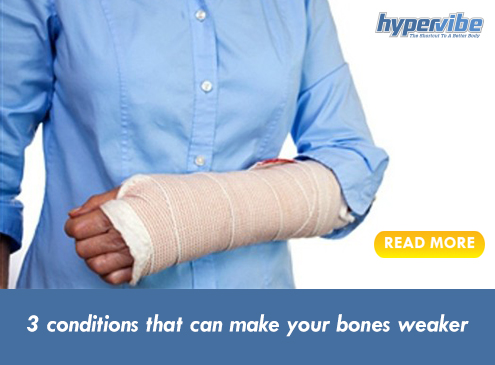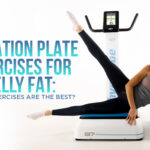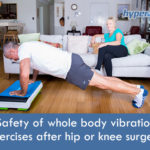
Just like any other tissues inside the human body, the bones renew themselves on a continue basis as we age, old cells being destroyed and new cells being produced for replacing the resorbed ones. As long as the balance between the destruction of old cells and formation of new bone tissue is in normal limits, the bones stay strong and healthy, but aging accelerates the resorption rate, causing the bones to become weaker and more fragile.
Getting enough calcium and minerals from foods, spending time in the sun for stimulating vitamin D synthesis, and practicing strength exercises that increase the load on bones are all important for maintaining healthy bones, but sometimes the weakening of the tissue is caused by an underlying condition and not by aging alone.
Although osteoporosis is the most known and common cause of weak bones, there are other diseases that can lead to fragile bones and can increase one’s risk of fractures.
A chronic condition that causes the bones to grow larger than normal and to become weaker, Paget’s disease of bone affects approximately 5% of women and 8% of men in the UK.
The disease appears mostly in adults aged 50 and above, men being more likely to develop it. Paget’s disease may affect one or several bones, and is more common in the legs, pelvis, spine and skull, but it doesn’t usually affect the entire skeleton.
Besides causing the bones to enlarge and weaken, this condition may also lead to arthritis and may cause additional health issues, like hearing loss or disorders of the inner ear, numbness or paralysis, cardiovascular problems and fractures.
It is not clear what triggers this condition, but what is certain is that Paget’s disease of bone appears when the balance between osteoblasts (cells that build new bone tissue) and osteoclasts (cells that help in disposing of old bone cells) gets altered. When this ratio is normal, the health of bone tissue is maintained, but in Paget’s disease sufferers, osteoblasts are hyperactive and produce too many new bone cells, hence the enlargement. Unfortunately this growth also makes the bones weaker and more prone to fractures.
It is believed that genetic and environmental factors are involved in the occurrence of this condition, as people with a family history are more prone to Paget’s disease of the bone, and people of certain races are also more likely to develop it.
Given that this condition often lacks other symptoms, lots of people don’t know they suffer from it, and find out accidentally, if they undergo imagistic exams for other conditions. However some do have symptoms such as skull deformities or enlarged head, bone and joint pain or stiffness, neck pain, leg deformities, headaches and warm skin over the affected bones.
Better known than Paget’s disease of the bone, hyperthyroidism is another condition that can make bones brittle and weak, and appears when the gland situated in the front of the neck produces too much thyroid hormone. The thyroid controls the metabolic processes that ensure the production of energy, but it also affects other systems, an excess or insufficient production of thyroid hormone having serious effects on the body.
Hyperthyroidism accelerates the heart rate, can make one sweat excessively, feel anxious or moody, or lose weight without any apparent reason. It can also affect the cholesterol levels and the health of one’s muscles, and over time can trigger osteoporosis by accelerating the bone resorption rate.
As previously mentioned, the normal bone density and structure is maintained through two opposite processes: first one is the destruction of old bone tissue, and the second is the formation of new cells. With age, the destruction tends to happen faster than the regrowth, and this explains the weakening of bones in older people.
The bone remodeling process is controlled by a series of hormones, among which PTH or parathyroid hormone, TSH or thyroid stimulating hormone and calcitonin. The interaction of these substances regulates the concentration of serum calcium, as well as the levels of other minerals in the bones. When the thyroid hormones are produced in excessive amounts, the breakdown of bones takes place faster than the regrowth, so the density of bones decreases and osteoporosis can occur.
The adult form of rickets, osteomalacia is caused by vitamin D deficiency, which is the result of abnormal bone mineralization. Manifesting through soft bones, lower back pain, or pain in the legs, hips or ribs, which usually gets worse at night, osteomalacia also leads to decreased muscle tone in the legs, weakness and waddling gait.
The condition may be asymptomatic in its early stages, so it’s not uncommon for sufferers to learn about their ailment during X-ray or diagnostic tests for other conditions. Although similar to osteoporosis, this condition is different in that it appears from a defect during the bone-building process, and not from the weakening of already constructed bone (osteoporosis). Both conditions, though, can increase one’s risk to fractures and decrease the quality of life.
Vitamin D deficiency, which is the main cause of osteomalacia, leads to low calcium and low phosphate levels, which at their turn cause hyperparathyroidism. So even if this may look like a bone condition only at first, it’s actually a more complex problem, which can affect the entire organism. The deficiency of this mineral is usually caused by insufficient exposure to sunlight or poor diet habits, but can also appear as a result of problems of the liver, kidneys or pancreas.
20-30 minutes of sunlight exposure, 2-3 times a week, are considered enough for the body to produce enough vitamin D for preventing osteomalacia. However in people with more pigmented skin or in the elderly, this time may vary, and one may also need to spend more time exposed to daylight if they live in an area that is not so sunny.
Have something to add to this article? Comment below or join our Facebook community and share your thoughts with us!

The lymphatic system plays a crucial role in your bodily...

Simply put, your muscles contract and relax in response to...

If you keep hearing more about the vibration plate lately,...

If you are suffering from back pain or lower back...

Whole body vibration exercises may not seem the safest choice...